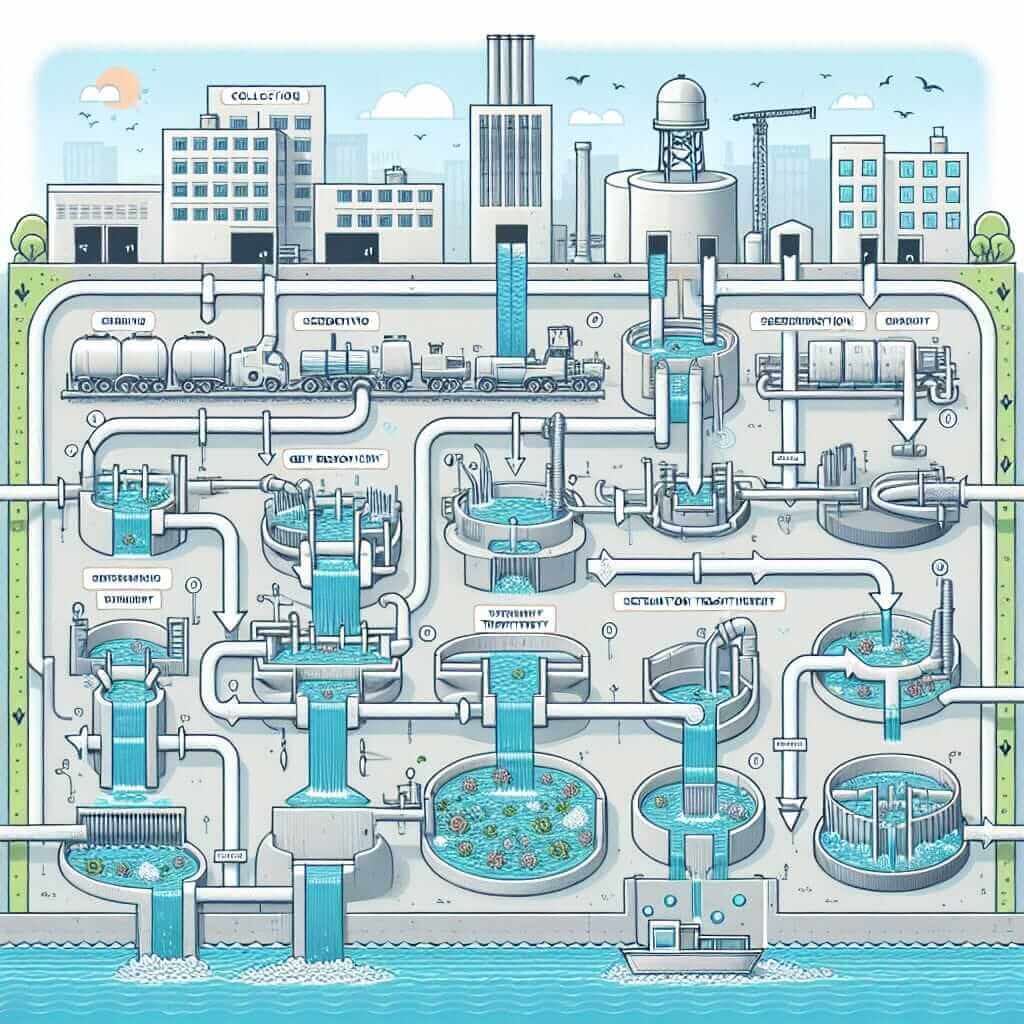The IELTS Writing Task 1 often presents candidates with diagrams illustrating industrial processes. One such process, frequently appearing in the exam, is “Urban Wastewater Treatment”. Understanding this process and mastering the language to describe it is crucial for achieving a high band score. This article provides a comprehensive guide to tackling such tasks, equipping you with the necessary vocabulary and insights.
Understanding the Task
Before delving into the specifics, let’s analyze common prompts related to “Urban Wastewater Treatment” that have appeared in past IELTS exams:
- The diagram below shows the process of treating wastewater in a typical urban area.
- The flow chart illustrates the different stages involved in purifying water for domestic use in a city.
- Describe the process of wastewater treatment, from its source to the point of discharge, as depicted in the diagram.
These prompts typically require you to:
- Provide an overview of the process.
- Describe the sequence of stages involved.
- Highlight key features and their purposes.
- Use appropriate vocabulary and grammar structures.
Sample Task
Let’s consider the following task:
The diagram below shows the stages involved in treating wastewater in a typical city. Write a report describing the process for a university lecturer.

Analyzing the Task
This task demands a clear and concise description of the urban wastewater treatment process as depicted in the provided diagram. The target audience is a university lecturer, implying the need for a formal tone and precise language.
Model Answer
The diagram illustrates the multi-stage process of treating wastewater in an urban setting, from its initial collection to the eventual discharge of treated water.
Initially, wastewater from households and industries is collected and channeled into the treatment plant. The first stage involves screening and grit removal, where large debris like rags and sand are separated using screens and grit chambers. This preliminary treatment ensures the smooth functioning of subsequent stages.
The next stage is primary treatment, which takes place in sedimentation tanks. Here, the wastewater is held for several hours, allowing heavier solids to settle at the bottom as sludge, while lighter materials float to the surface as scum. Both the sludge and scum are then removed.
Following primary treatment, the partially clarified wastewater proceeds to secondary treatment. This stage utilizes biological processes to further purify the water. In the aeration tank, microorganisms consume organic matter, breaking it down into less harmful substances. The water then flows to a secondary sedimentation tank, where remaining solids settle out.
The final stage, tertiary treatment, aims to further refine the water quality before discharge. This may involve filtration through sand or gravel beds to remove fine particles, followed by disinfection using chlorine or ultraviolet light to eliminate harmful bacteria and viruses. The treated water, now safe for discharge, is released back into rivers or other water bodies.
In conclusion, the urban wastewater treatment process effectively removes pollutants through a series of physical, biological, and chemical processes, ensuring the safe disposal of wastewater and protecting public health and the environment.
(Word count: 217)
Key Considerations
Vocabulary:
- Influent: Wastewater entering the treatment plant.
- Effluent: Treated water discharged from the plant.
- Sedimentation: The process of particles settling to the bottom of a liquid.
- Aeration: The process of introducing air into water to increase oxygen levels.
- Disinfection: The process of killing harmful microorganisms.
- Sludge: The semi-solid waste material removed during treatment.
Grammar:
- Use present simple tense to describe the process.
- Use passive voice where appropriate (e.g., “Wastewater is collected.”).
- Use sequencing words to connect stages (e.g., “Firstly,” “Next,” “Finally”).
Essential Vocabulary
- Coagulation (n) /koʊˌæɡjʊˈleɪʃən/: The process of causing small particles to clump together.
- Flocculation (n) /ˌflɒkjʊˈleɪʃən/: The process of gathering together into a mass.
- Activated sludge (n) /ˈæk.tɪ.veɪ.tɪd slʌdʒ/: Sludge that has been aerated and contains microorganisms that break down organic matter.
- Clarifier (n) /ˈklær.ɪ.faɪ.ər/: A tank used for sedimentation.
- Ultraviolet (UV) radiation (n) /ˌʌl.trəˈvaɪə.lət ˌreɪ.diˈeɪ.ʃən/: A type of electromagnetic radiation used for disinfection.
Conclusion
Mastering the language and structure required to describe processes like urban wastewater treatment is essential for achieving a high band score in the IELTS Writing Task 1. Remember to analyze the diagram carefully, use appropriate vocabulary and grammar, and present your answer in a clear and organized manner. By following these tips and practicing regularly, you can approach this section of the IELTS exam with confidence.